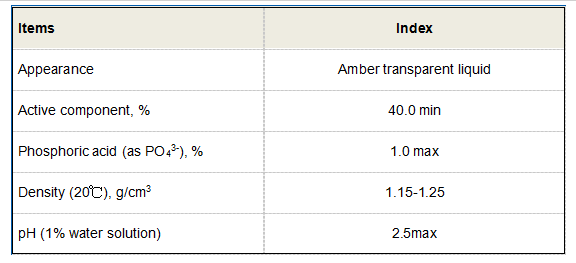amino trimethylene phosphonic acid atmp
Amino Trimethylene Phosphonic Acid (ATMP) Properties, Applications, and Significance
Amino trimethylene phosphonic acid (ATMP) is a versatile organophosphonic acid that has gained significant attention in various industrial applications, particularly in water treatment, scale inhibition, and as a chelating agent. Its unique chemical structure, characterized by the presence of phosphonic acid groups along with amino functionalities, imparts several advantageous properties that make it a valuable compound in different sectors.
Chemical Structure and Properties
ATMP is represented by the molecular formula C4H12N3O6P. Its structure includes a phosphonate group attached to a trimethylene (three-carbon) chain with amino (-NH2) groups. The presence of these functional groups enables ATMP to engage in multiple chemical interactions, effectively chelating metal ions and inhibiting the formation of scale deposits. The molecule exhibits excellent solubility in water, making it particularly effective in aqueous solutions, which is a desirable characteristic for many industrial applications.
One of the most remarkable properties of ATMP is its ability to form stable complexes with metal ions such as calcium, magnesium, and iron. This chelating ability is highly beneficial in preventing scale formation in various systems, such as boilers and cooling towers, where mineral deposits can lead to operational inefficiencies and costly maintenance.
Applications in Water Treatment
The primary application of ATMP lies in water treatment processes. In industrial settings, the presence of hard water — water containing high concentrations of calcium and magnesium ions — often leads to scaling. Scaling not only affects the efficacy of equipment but can also result in increased energy consumption. ATMP acts as a scale inhibitor, preventing the precipitation of these minerals and maintaining system efficiency.
ATMP is commonly used in formulations for cooling water treatments, boiler water treatments, and in oilfield applications. By inhibiting scale formation, ATMP helps ensure that systems operate smoothly, avoiding clogs and minimizing the need for chemical cleaning or mechanical maintenance.
amino trimethylene phosphonic acid atmp

Role in Detergency and Cleaning Products
In addition to water treatment, ATMP is also utilized in cleaning products and detergents. Its chelating properties allow it to bind to metal ions that may react with surfactants in cleaning formulations, thereby enhancing the efficacy of the products. By preventing the interference of metal ions, ATMP contributes to better cleaning performance and improved product stability.
Agricultural Applications
The agricultural sector has also recognized the significance of ATMP. It can be employed as a chelating agent in fertilizers to improve the bioavailability of essential nutrients such as iron, manganese, and zinc. By enhancing nutrient absorption, ATMP can help optimize plant growth and productivity, making it an important component in modern agricultural practices.
Environmental Considerations
As with any chemical, the use of ATMP brings certain environmental considerations. While it is generally regarded as safe when used within regulatory limits, there are ongoing discussions regarding the biodegradability of phosphonic acids and their potential impact on aquatic ecosystems. Therefore, it is crucial for industries to adhere to environmental regulations and guidelines to minimize any adverse effects.
Conclusion
In summary, amino trimethylene phosphonic acid (ATMP) is a multifunctional compound with significant applications across various industries, primarily in water treatment and cleaning solutions. Its scale inhibition and chelating abilities make it an essential ingredient for improving system efficiencies and performance. As industries continue to seek effective and sustainable solutions for their operational challenges, ATMP is likely to remain a valuable component, contributing positively to both productivity and environmental stewardship. Continued research and development may further enhance its applications, paving the way for more innovative uses in the future.
-
lk-319-special-scale-and-corrosion-inhibitor-for-steel-plants-advanced-solutions-for-industrial-water-systemsNewsAug.22,2025
-
flocculant-water-treatment-essential-chemical-solutions-for-purification-processesNewsAug.22,2025
-
isothiazolinones-versatile-microbial-control-agents-for-industrial-and-consumer-applicationsNewsAug.22,2025
-
scale-inhibitor-key-solutions-for-water-system-scale-preventionNewsAug.22,2025
-
organophosphonates-versatile-scale-inhibitors-for-industrial-water-systemsNewsAug.22,2025
-
scale-and-corrosion-inhibitor-essential-chemical-solutions-for-water-system-maintenanceNewsAug.22,2025





